The Well-Equipped Engineer’s Truck

[August 2012] Contract engineering can provide a satisfying, well-paid business for the broadcast engineer who likes to handle a variety of challenges. As Richard Rudman explains, one challenge is making sure you have all the tools and supplies you will need – wherever you are.
Good News, Bad News
So here is the Good News: You are out on your own as a contract broadcast engineer – and you are the boss! You have gained years of solid experience working in a corporate environment and now can put that to use for your clients.
Then there is the Bad News: You are leaving a world where you had a stock of spare parts, spare modules, company-supplied tools, and sometimes – even in this “do it with less” corporate mind set – a company-supplied vehicle.
During your first trip on your first contract to a mountaintop transmitter site, you may begin to miss your old life and all its corporate security blankets.
However, if your focus is right, the Good will greatly outweigh the Bad. This article can help you not only become better prepared for that first trip but get you closer to embracing your new life with greater confidence and enthusiasm.
Meeting the New Challenges
OK, now it is time to confront your first off-air emergency on a cold, snowy evening.
As you drive up to the fire-road gate to deal with the problem, you look up the combination for the lock on the gate chain in your PDA. Unfortunately, the combination will not work. You call the client and he tells you, “The lock must be busted. Do whatever you have to.”

Starting with the least invasive methods, you first take out a small butane torch and gently heat the frozen lock. No luck. You flood the lock with your favorite spray and spin the combo wheels. No luck. So, undaunted, you get out your deluxe bolt cutters and part the chain close to the side of the lock. After going through the gate, you take out a new combo lock that you thoughtfully stocked on your truck, program it for the combo you were given, and relock the gate behind you.
As you see, it helps to carry a lock and some chain on hand.
Drive Carefully
As it turns out, the road to the site is just slightly less than perfect.
In fact, you have to drop into 4-wheel low gear to safely traverse an uphill stretch of slippery mud and snow. That is of course, if you have an off-road, 4-wheel drive vehicle with off-road rated tires, and have some training on navigating mountain roads safely.
Arriving at the site, you have a similar cold weather problem with the building lock. Fortunately, this time the torch works, and you open the door and step inside. The building has power, but the exciter and transmitter are dark.
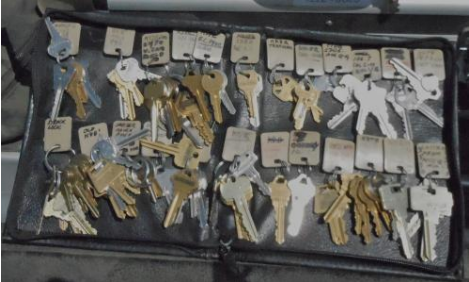
Part by Part Diagnosis
The exciter primary AC fuse is blown, so you go out to your truck and dig out a replacement from your fuse stock. The exciter lights up, but you find a fried resistor in the transmitter power control circuitry. Back to the truck to find a close replacement – and to bring in your soldering kit.
The lesson here is all too obvious. When you are out on your own and charged with maintaining sites you may never have been to before, there rarely is an electronics or hardware store in the neighborhood should you forget something, or find an unexpected problem.
I say in jest that my truck has “half a hardware store” on it. That may be only a slight exaggeration. In addition to a wide variety of tools and test equipment, I carry plastic bins with lots of nuts, bolts and hardware running anywhere from small metric and SAE threads to an assortment of bolts up to ¾” diameter.

I also have quite an assortment of connectors and adapters that include DB-9’s through DB37’s, male and female XLR connectors, and more.
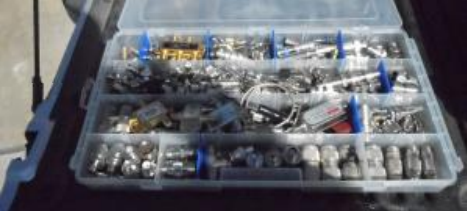
My RF adapter kit has SME to BNC’s, type F adapters of all types to all types, as well as the standard range of Type N and UHF connectors. I have had very few instances of not being able to adapt connections at remote transmitter sites without having to go back down the hill to the electronics store.
Test Gear
While a DVM can be a good tool, if that is all you have at hand, you will find it hard to diagnose – much less fix – many common problems you will encounter. Be sure you have the right tools for the job.
Over ten years, I have accumulated some good test equipment. Copying an idea from a Ventura colleague, Chuck Hastings, I built up a portable case housing both an AM and FM modulation monitor, with AC and BNC connectors mounted on the back.
Additionally, I carry
- an IFR spectrum analyzer/tracking generator
- a second IFR spectrum analyzer
- an RF Wattmeter and an assortment of slugs
- a 250 Watt, 50 Ohm dummy load, and a number of clip on and standard meters.
But there is more that needs to be available on a work site, including:
- a Potomac FIM
- several portable DC inverters
- an inverter/ air pump box
- a Tektronix scope
- an Ethernet cable verifier and tools
- CAT 5 cable and connectors to build custom RJ-11 and RJ-45 cables.
Carrying It All
One small toolbox contains nothing but fresh AAA, AA, C, 9 Volt, and D batteries.
Fitting all this in a Ford F-150 was a challenge. I purchased a permanently installed heavy duty, generous size slide-out drawer after not being able to find something in the back of the truck one too many times.
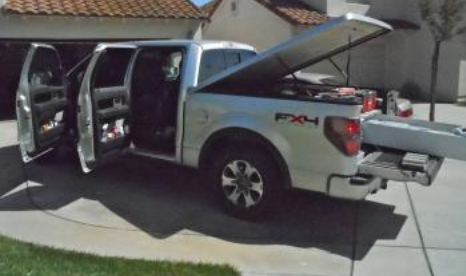
I even have put some labels on the lip of the truck bed in case I forget where I put my shovel, jumper cables, hip boots, hard hats, and other things I do not use too often – there is no label needed for a small step ladder that goes everywhere with me – it sits on top of everything else.
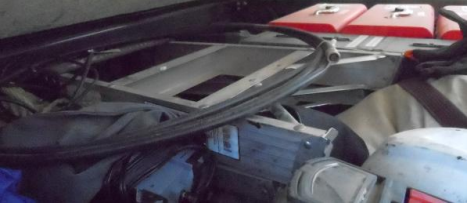
Because of the design of the crew cab F-150, there is a lot of space for large items when I flip up the rear passenger seats. Liquid cleaners, lubricants, etc. fit nicely in the door wells.
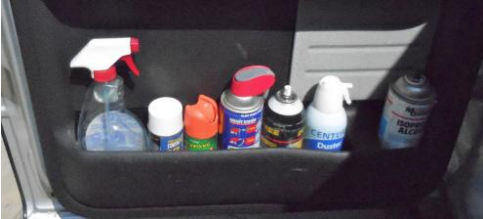
Larger items usually live in my garage, for example, and include (but are not limited to) ladders, a collapsible 12-foot ladder, work tables, and a drill press.
Fuses and components are a challenge. I cannot know for certain that I always will have the exact fuse I need, but hopefully I can come close. The same holds true for resistors, capacitors, diodes, and other passive components.
 I have small toolboxes holding various types of needs. One contains my plug-in tools. Another holds battery-powered tools. Two boxes hold nothing but an assortment of drills for metal, wood, and masonry.
I have small toolboxes holding various types of needs. One contains my plug-in tools. Another holds battery-powered tools. Two boxes hold nothing but an assortment of drills for metal, wood, and masonry.
An engineer’s measurement needs are not limited to electronics. I carry a number of tape measures including a 100-foot tape on a reel. There is also an inclinometer and old fashioned compass needed for dish alignment.
Parts For Yourself, Too!
I always carry basic emergency food and water with me. I take more if I know I am going into a really remote site.
It is best to have a small cooler on hand so you can pack your favorite beverages and transmitter site comfort food. If you take prescription medicines, you need to get an extra stock for your truck that you change out periodically.
By the way, do not forget the need for a good first aid kit – one that can deal with more than a cut finger.
Try to Anticipate Your Needs
There is one slight confession I need to make: I do not carry a large stock of solid state and large passive components on the truck.
If I did try to have some of everything, I would need a much larger truck. So, some guesswork is involved in choosing what to take on any job. That is a prelude to saying that while you can try to prepare for everything, you just cannot.
But with some thought and planning, you can be prepared for almost everything. By now, you can see that this article is meant as a thought-provoker to challenge you to equip your vehicle with what you need. If you have been provoked to come up with other ideas that might help me or others, the BDR is a good place to send them.
– – –
After a long career including as Chief Engineer at Westinghouse and CBS stations, Richard Rudman has been doing contract engineering in Southern California for the past ten years. Contact him at rar01@mac.com
